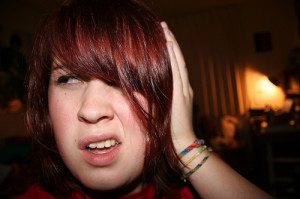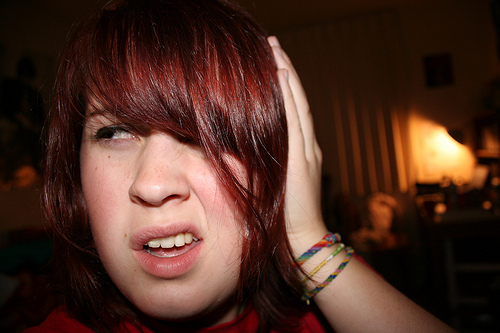Misophonia, literally hatred of sound, is a term that was introduced in 2001 by American scientists Pawel J. and Margaret M. Jastreboff to describe abnormally strong negative reactions to everyday sounds that range from chewing and throat clearing, to lip smacking, pen clicking, and cell phone texting.

“I keep a list of friends that I know I can’t sit next to when out for dinner,” said Alessia Di Cesare, a psychology graduate at Concordia University, who can’t stand the sound of people chewing with their mouth open.
Di Cesare believes she has a mild form of the little-known disorder.
According to Drs. Jastreboff, patients commonly report certain triggering factors related to misophonia and hyperacusis (an over-sensitivity to sound that is perceived as abnormally loud or physically painful). These triggers include chronic exposure to sound and impulse noise (abrupt, unwanted and often loud sounds like gunshots or fireworks); head injury and/or surgery; stress associated with an event such as a dental procedure; or sounds associated with new surroundings such as college cafeterias and new living spaces.
People with misophonia experience a range of negative reactions to sound.
“I find myself feeling anxious, irritable, aggressive and angry,” said Di Cesare.
The type of reaction depends on non-auditory factors, such as the persons’ previous attitudes towards the sound in question, their psychological profile, and the context in which the sound is presented.
Audiologist Marsha Johnson believes the condition tends to appear in the early teens and worsens with time. For Di Cesare, the symptoms began two years ago and have since worsened.
“When I hear people chewing with their mouth open, I walk away,” said Di Cesare.
In an interview published by the New York Times, Dr. Johnson stated that because the condition remains poorly studied and understood, people with misophonia are often diagnosed as sufferers of phobic and obsessive-compulsive disorders, or as being bipolar, manic, and anxious.
Diagnosis of misophonia is complex and involves an audiological test measuring what is known as the loudness discomfort level of the individual and a specific, detailed interview with the patient. In practice, hyperacusis and misophonia frequently occur together. In patients with significant hyperacusis, misophonia is automatically created because the discomfort of normal sounds automatically elicits negative reactions.
Aage R. Moller, a neuroscientist at the University of Texas at Dallas who specializes in the auditory nervous system, stated in the medical guidebook Textbook of Tinnitus that there is no known effective treatment for the condition. Dr. Moller believes the condition is probably not an auditory disorder but a “physiological abnormality” within the brain.
Because of the lack of treatment, Di Cesare has made lifestyle changes to keep her symptoms in check.
“Dinner with my family was a challenge until I made having the radio on a rule at the table…anything to muffle the sound of chewing,” she said.
The lack of research on the disorder has left many sufferers of misophonia turning to online forums and blogs to look for support. In the hope of sparking interest, Dr. Johnson has set-up a group called Selective Sound Sensitivity that provides support, information, and awareness about misophonia.





I have severe misophonia and as far as “impulse noises” go, I am bothered by very abrupt loud sounds, though I am also bothered by just as many random sounds which are all but in audible to anyone else. The thing is, I don’t have sensitive hearing. My mind is hyper-aware of the environment around me. The main difference between those who have misophonia and everyone else, is that once we notice a sound that bothers us, it doesn’t matter if we hear it ten thousand times after that; each time will bother us as though a reaction has been tuned on that we cannot shut down now matter how hard we try to force it out, or relax and let it go. The reactions continue to build to become very severe and painful, and often times during high school I had to hide my head in my hands so that people wouldn’t see me crying uncontrollably.
Thank you attempting to report on this difficult and misunderstood condition. We need all the publicity we can get to help others recognize that they and/or loved ones have this disorder and that they aren’t alone.
I must point out that those who read this article and recognize their own sound sensitivity will come away with incorrect and/or misleading information . . .
*Misophonia and Hyperacusis are distinct and different disorders with different origins and they do not frequently occur together.
*Misophonia is not brought about by an impulse noise.
*Misophonia sound sensitivity is not brought on by stress, by previous attitudes, or by context.
*Misophonia (according to Dr. Aage Moller) is a disorder of hard-wiring neurological circuits in the brain. It is not tested or diagnosed by audiological testing for loudness
*Misophonia is neurological, it is not psychological and it is not audiological.
I will quote text from your article here “Dr. Moller believes the condition is probably not an auditory disorder but a “physiological abnormality” within the brain.”
I hope that the people who read this piece will look further for information and clarification. There is very little Misophonia research being done on a neurological level (where the research belongs) but we have made great strides in getting publicity.
Thank you for the publicity.
Also see the book “Sound-Rage. The Neurobiology and Psychology of a Little Known Anger Disorder (210 pgs.)
Radio Health Journal podcast with Moller and Sound-Rage author, called Misophonia, can be downloaded for free on iTunes.